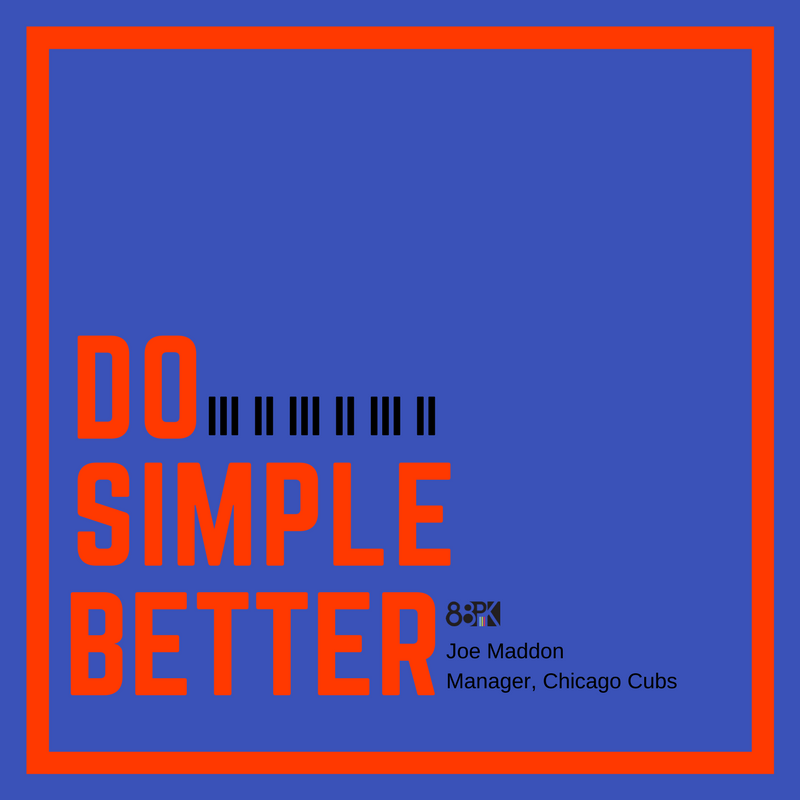Do Simple Better
As teachers, it’s our job to make things clear. This often requires introducing new concepts by breaking them up into bite-sized nuggets that can be quickly understood. We must make the seemingly difficult appear simple. I recently stumbled upon this quote by Joe Maddon, the manager who led the Cubs to their first World Series title in over 100 years:
“Do simple better.”
It got me asking: what would Maddon’s challenge look like on the piano bench?
I came up with four examples of doing SIMPLE better and labelled them:
Expand then extract
Play then say
Explore then explain
Lead then let go
The video below (click here if you can't see it) expands on these four items.
Read my article below, too.
I mention a number of teaching tools in the video so here are some links to them:
Cowboy World by Lynda Lybeck-Robinson
Rainbow Prelude by Jennifer Linn
Rhythm Produce by Leila Viss
FYI: My cool t-shirt in the video is courtesy of Heather Nanney. Take a look at her blog here.
If you'd like to create your own Make-a-Wish Jars and wish cards for your studio, just enter your name and email address below.
I used these jars at a recent Piano Party for student families. I asked my parents and students to write down their wishes for their piano study in upcoming year and place them in the jars. It was like opening a gift every time I read each wish. You DEFINITELY should do this!
Do Simple Better
As teachers, it's our job to make things clear. It usually means that we need to introduce new concepts and break them up into bite-sized nuggets that can be understood quickly. We must make the seemingly difficult appear simple.
Recently I stumbled upon this quote by John Madden, the manager who led the Cubs to their first World Series title in over 100 years.
Do simple better.
This got me thinking. What would Madden’s challenge look like on the piano bench? After some thought, I came up with at least 4 ways to do “simple” better. It didn’t occur to me until after making this list that the ways listed below are rooted in two fundamental skills: student listening and student self-assessment.
Expand THEN Extract
SIMPLE
After a piece is selected, it's important for students to experience the landscape of the piece by listening to a professional performance and hear the “ultimate goal.” Then it’s time to break the piece into smaller goals by mapping the form and working on one section at a time hands alone, at a slow tempo and then hands together and gradually increasing the tempo.
SIMPLE BETTER
When it’s time to play hands together, slice up sections into phrases or musical sentences and identify exactly how far to practice by using a red tab. This serves as a “stop sign” and makes it clear that practice stops there for the week.
Within the designated section, use sticky notes to set additional limitations. Place one on the score so that students’ eyes focus only on beat one of the first measure. Once students can play it without errors as determined by both the teacher and students, move the sticky note to reveal beats 1 and 2 and ask students to play both beats. When they can play this error-free, move the sticky note to the next beat and continue until the first measure can be played with accuracy and flow.
This process requires patience but, success in small packages is the key to progress. This is crucial when working on more difficult sections that include tricky rhythms, coordination between hands and complex fingering.
Assigning students to follow this procedure only up to the stop sign can eliminate anxiety about the huge project that lies ahead. Setting boundaries that require self-assessment skills combined with positive results will boost student confidence, and may even nudge them to bypass the stop sign and keep going!
Play It THEN Say It
SIMPLE
To make students aware of all dynamics within a score, it’s helpful for them to highlight all signs in the score and assign them to play dynamic changes as they practice a piece.
SIMPLE BETTER
Although highlighting dynamic changes alerts students’ eyes, it may not always alert their ears. Instead of reminding them to add them when they forget, ask students to listen to you play a phrase two ways. First play it with no dynamic changes. Then play again with all the indicated dynamic changes. Ask them to describe what was different. Then ask them to echo your playing until you both hear the desired and indicated dynamic changes. Extend this discussion further and ask students why the composer added the dynamics as indicated.
This memorable activity will elevate student listening skills and prompt them to look for AND listen for all dynamic markings in the future.
Explore THEN Explain
SIMPLE
A new concept, like a major five finger pattern, is typically introduced with an explanation of whole and half steps. Students are advised to use their knowledge of both steps and identify the need for a half step between scale degrees 3 and 4 to create a major pattern. Transferring this knowledge to other pitches is a natural progression in mastering the major pattern on additional keys.
SIMPLE BETTER
Before asking students to measure and identify the pattern of whole and half steps, invite students to play the pattern beginning on C and then on another white key, like D. As they begin on D and play ascending white keys, their ears will discover that the sound produced does not match the “major sound” heard on C.
This is the ideal time to encourage inquiring minds to measure half and whole steps beginning on C and then do the same on D. Comparing both patterns, students will notice that a black key is required to create the same pattern of steps resulting in a “major” sound on D.
Inviting students to explore and create within these patterns first before explaining the complex system of whole and half steps can build discernment in listening skills while reinforcing the important concepts.
Lead THEN Let Go
SIMPLE
As teachers, our job is to instruct, problem solve, provide constructive comments and ask questions to guide student learning. These are definitely not easy tasks for just any one, but as our experience widens, they become standard in our teaching—they become “simple” to us.
SIMPLE BETTER
What is simple to us is exactly what we need to pass along to our students if we want them to become independent and high-functioning musicians. To do this, we must hand over the responsibilities of listening, asking questions and assessment to our students.
This transfer of responsibilities starts with students discerning between sounds and learning how to ask questions when they need help. It continues when they listen to their own playing and evaluate their performances before you give your feedback. It develops further when students create their own music, solve problems using the steps and tips you’ve given them along with their highly developed listening skills.
Leading students into the world of music is all about making things simple. Encouraging students to explore, extract, play first, and ultimately letting them go is doing simple better.



